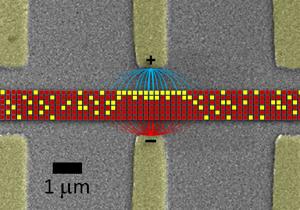
Manganite wires confined to scales on the order of the insulating and metallic domains residing within were biased using lateral gates near the metal-insulator transition. The results conform to a phenomenological model in which the inherent nanoscale insulating and metallic domains are rearranged through electrophoretic-like processes to open and close percolation channels. Since electronic phase competition is present in such a broad spectrum of complex materials, these findings are expected to have an impact on our understanding of many classes of materials, from high temperature superconductors to multiferroics.
Hangwen Guo, Joo H. Noh, Shuai Dong, Philip D. Rack, Zheng Gai, Xiaoshan Xu, Elbio Dagotto, Jian Shen, and T. Zac Ward, “Electrophoretic-like gating used to control metal–insulator transitions in electronically phase separated manganite wires,” Nano Lett. 13, 3749–3754 (2013). DOI: 10.1021/nl4016842
For more information

